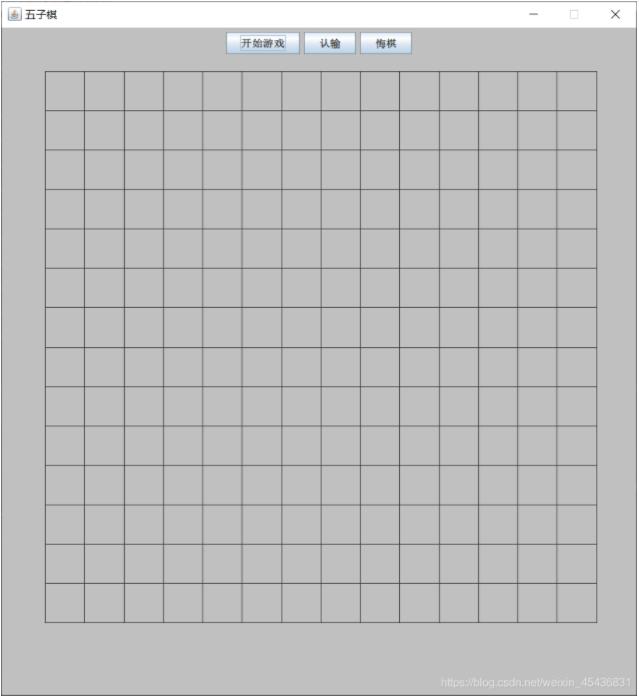前言
之前学完java基础课程,试着简单做了一下java的一个五子棋小游戏,记录下来。
界面
由于直接用的java库中的一些基本控件写的一个GUI,并没有做过多优化,感觉比较丑
下面是界面展示:

黑子先行,但是我这边简化规则,并没有考虑黑子先行的一些禁手。
下面直接贴代码
接口类
我把五子棋界面的一些常量都定义在了这个接口类中,包括棋盘的起始坐标,棋盘线的间距和棋子半径
public interface constant {
int[][] chessLocation = new int[15][15];
static final int x = 50; //左上角位置
static final int y = 50;
static final int LN = 15; //棋盘一些常量
static final int R = 45;
}
实现类
接口
这个类中继承了 constant、MouseListener、ActionListener三个接口
其中:
- constant为自己定义
- MouseListener为鼠标监听
- ActionListener为事件监听
函数
show()绘制窗口基本框架
paint()绘制棋盘网格线和棋子
IsWin()判断输赢的基本逻辑
mouseClicked()获取鼠标位置,判断棋子落点等
actionPerformed()判断鼠标点击哪个按钮(开始游戏or认输or悔棋)执行相应操作
import java.awt.Color;
import java.awt.Graphics;
import java.awt.event.ActionEvent;
import java.awt.event.ActionListener;
import java.awt.event.MouseEvent;
import java.awt.event.MouseListener;
import javax.swing.JButton;
import javax.swing.JFrame;
import javax.swing.JOptionPane;
import javax.swing.JPanel;
public class game_logic extends JPanel implements constant, MouseListener, ActionListener {
int chess_x = 0, chess_y = 0;
int X = 0, Y = 0;
boolean IsBlack = true; //判断黑白
boolean flag = false; //是否已经开始游戏
//生成三个响应按钮
JFrame frame = new JFrame();
JButton start = new JButton("开始游戏");
JButton regret = new JButton("悔棋");
JButton Lost = new JButton("认输");
public void ShowUI() {
frame.setSize(740, 800);
frame.setTitle("五子棋");
frame.setDefaultCloseOperation(JFrame.EXIT_ON_CLOSE);//点击关闭结束程序
frame.setLocationRelativeTo(null);//窗口居中
frame.setVisible(true);//窗体可视化
frame.setResizable(false);//窗体大小不可调整
frame.add(this);
this.setBackground(Color.LIGHT_GRAY);//设置背景颜色
this.addMouseListener(this);//窗体中添加鼠标监听器
start.setSize(50, 80);//设置按钮大小
start.addActionListener(this);//按钮添加事件监听器
Lost.setSize(50, 80);
Lost.addActionListener(this);
regret.setSize(50, 80);
regret.addActionListener(this);
this.add(start);//添加按钮到棋盘上
this.add(Lost);
this.add(regret);
}
/**
* 绘制方法
* 绘制五子棋棋盘
* @param g
*/
@Override
public void paint(Graphics g) {
super.paint(g);
for (int i = 0; i < LN; i++) { //画棋盘
g.drawLine(x, y + i * R, x + (LN - 1) * R, y + i * R);//行*15
g.drawLine(x + i * R, y, x + i * R, y + (LN - 1) * R);//列*15
}
for (int i = 0; i < LN; i++) { //画棋子
for (int j = 0; j < LN; j++) {
if (chessLocation[i][j] == 1) {
g.setColor(Color.BLACK);//黑棋先行
g.fillOval(50 + i * R - 23, 50 + j * R - 23, R, R);
}
if (chessLocation[i][j] == 2) {
g.setColor(Color.WHITE);
g.fillOval(50 + i * R - 23, 50 + j * R - 23, R, R);
}
repaint();
}
}
}
/**
*判断输赢
*
*/
public int IsWin() {
int k = 0;
for (int f = 2; f < 12; f++) {
for (int g = 2; g < 12; g++) {
if (chessLocation[f][g] == 1) {
if (chessLocation[f][g] == chessLocation[f - 1][g] && chessLocation[f - 1][g] == chessLocation[f - 2][g] && chessLocation[f - 2][g] == chessLocation[f + 1][g] && chessLocation[f + 1][g] == chessLocation[f + 2][g]) {
k = 1;
break;
}
if (chessLocation[f][g] == chessLocation[f][g - 1] && chessLocation[f][g - 1] == chessLocation[f][g - 2] && chessLocation[f][g - 2] == chessLocation[f][g + 1] && chessLocation[f][g + 1] == chessLocation[f][g + 2]) {
k = 1;
break;
}
if (chessLocation[f][g] == chessLocation[f - 1][g - 1] && chessLocation[f - 1][g - 1] == chessLocation[f - 2][g - 2] && chessLocation[f - 2][g - 2] == chessLocation[f + 1][g + 1] && chessLocation[f + 1][g + 1] == chessLocation[f + 2][g + 2]) {
k = 1;
break;
}
if (chessLocation[f][g] == chessLocation[f - 1][g + 1] && chessLocation[f - 1][g + 1] == chessLocation[f - 2][g + 2] && chessLocation[f - 2][g + 2] == chessLocation[f + 1][g - 1] && chessLocation[f + 1][g - 1] == chessLocation[f + 2][g - 2]) {
k = 1;
break;
}
}
if (chessLocation[f][g] == 2) {
if (chessLocation[f][g] == chessLocation[f - 1][g] && chessLocation[f - 1][g] == chessLocation[f - 2][g] && chessLocation[f - 2][g] == chessLocation[f + 1][g] && chessLocation[f + 1][g] == chessLocation[f + 2][g]) {
k = 2;
break;
}
if (chessLocation[f][g] == chessLocation[f][g - 1] && chessLocation[f][g - 1] == chessLocation[f][g - 2] && chessLocation[f][g - 2] == chessLocation[f][g + 1] && chessLocation[f][g + 1] == chessLocation[f][g + 2]) {
k = 2;
break;
}
if (chessLocation[f][g] == chessLocation[f - 1][g - 1] && chessLocation[f - 1][g - 1] == chessLocation[f - 2][g - 2] && chessLocation[f - 2][g - 2] == chessLocation[f + 1][g + 1] && chessLocation[f + 1][g + 1] == chessLocation[f + 2][g + 2]) {
k = 2;
break;
}
if (chessLocation[f][g] == chessLocation[f - 1][g + 1] && chessLocation[f - 1][g + 1] == chessLocation[f - 2][g + 2] && chessLocation[f - 2][g + 2] == chessLocation[f + 1][g - 1] && chessLocation[f + 1][g - 1] == chessLocation[f + 2][g - 2]) {
k = 2;
break;
}
}
}
}
return k;
}
@Override
public void mouseClicked(MouseEvent e) {
X = e.getX();
Y = e.getY(); //获取鼠标位置
if (flag == true) {
if (X >= 25 && X <= 705 && Y >= 25 && Y <= 705) { //比棋盘稍微大一点的落子判定范围,即棋盘边缘位置
//应该安放的棋子的位置
chess_x = (X - 20) / R;
chess_y = (Y - 20) / R;
if (chessLocation[chess_x][chess_y] == 0) { //存储棋子状态,转换棋子颜色
if (IsBlack == true) {
chessLocation[chess_x][chess_y] = 1;
IsBlack = false;
} else {
chessLocation[chess_x][chess_y] = 2;
IsBlack = true;
}
if (IsWin() == 1) {
JOptionPane.showMessageDialog(this, "黑棋获胜");
flag = false;
}
if (IsWin() == 2) {
JOptionPane.showMessageDialog(this, "白棋获胜");
flag = false;
}
repaint();
}
}
}
}
@Override
public void mousePressed(MouseEvent e) {
}
@Override
public void mouseReleased(MouseEvent e) {
}
@Override
public void mouseEntered(MouseEvent e) {
}
@Override
public void mouseExited(MouseEvent e) {
}
@Override
public void actionPerformed(ActionEvent e) {
String buttonName = e.getActionCommand();
if (buttonName.equals("开始游戏") && flag == false) {//开始游戏,棋盘清空
flag = true;
for (int i = 0; i < LN; i++) {
for (int j = 0; j < LN; j++) {
chessLocation[i][j] = 0;
}
}
IsBlack = true;
repaint();
}
if (buttonName.equals("认输") && flag == true) {
flag = false;
if (IsBlack) {
JOptionPane.showMessageDialog(this, ",白棋认输,黑棋获胜");
} else {
JOptionPane.showMessageDialog(this, ",黑棋认输,白棋获胜");
}
}
if (buttonName.equals("悔棋") && flag == true) {
if (chessLocation[chess_x][chess_y] == 1) {
JOptionPane.showMessageDialog(this, "黑方悔棋");
}
if (chessLocation[chess_x][chess_y] == 2) {
JOptionPane.showMessageDialog(this, "白方悔棋");
}
chessLocation[chess_x][chess_y] = 0;
IsBlack = !IsBlack;
repaint();
}
}
}
其中比较有趣的是五子棋判赢方式,假设棋盘大小15*15,则我只需要判断正中间的13*13d的格子,向两边扩展,判断是否五子连珠。
具体说明代码里都有注释,不多赘述。
主函数类
public class Main_game {
public static void main(String[] args) {
game_logic start=new game_logic();
start.ShowUI();
}
}
总结
实现了五子棋小游戏的基本功能,但是略感粗糙,细节不足。对于基本控件调用一学就会,做一个小的游戏demo这是对流程控制和操作逻辑的训练很有效的一种方式。之前看了别人的代码觉得简单,但是自己写的时候往往逻辑流程难以连续,思维混乱,有些过程只有自己写了才知道其中的坑。
以上就是本文的全部内容,希望对大家的学习有所帮助,也希望大家多多支持自学编程网。

- 本文固定链接: https://zxbcw.cn/post/218059/
- 转载请注明:必须在正文中标注并保留原文链接
- QQ群: PHP高手阵营官方总群(344148542)
- QQ群: Yii2.0开发(304864863)
